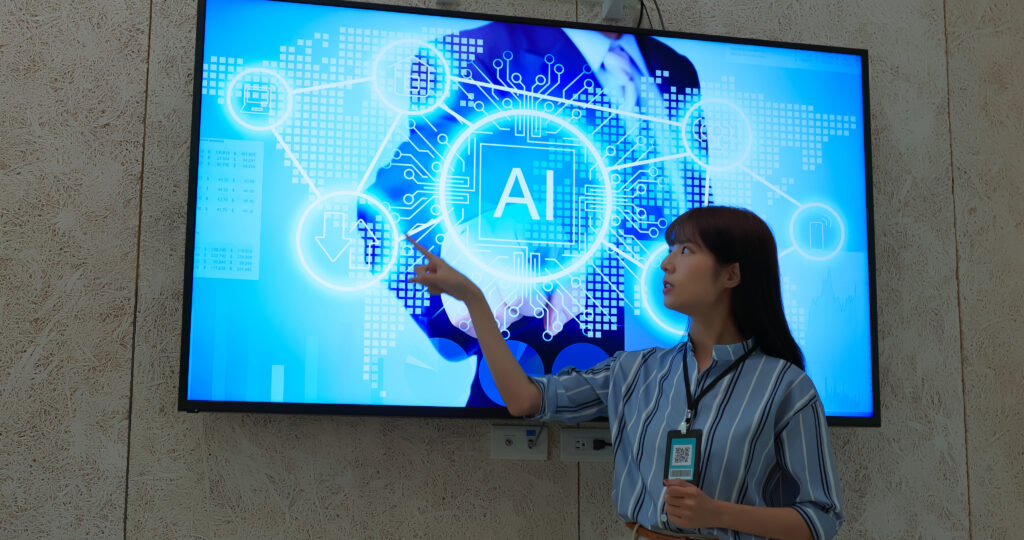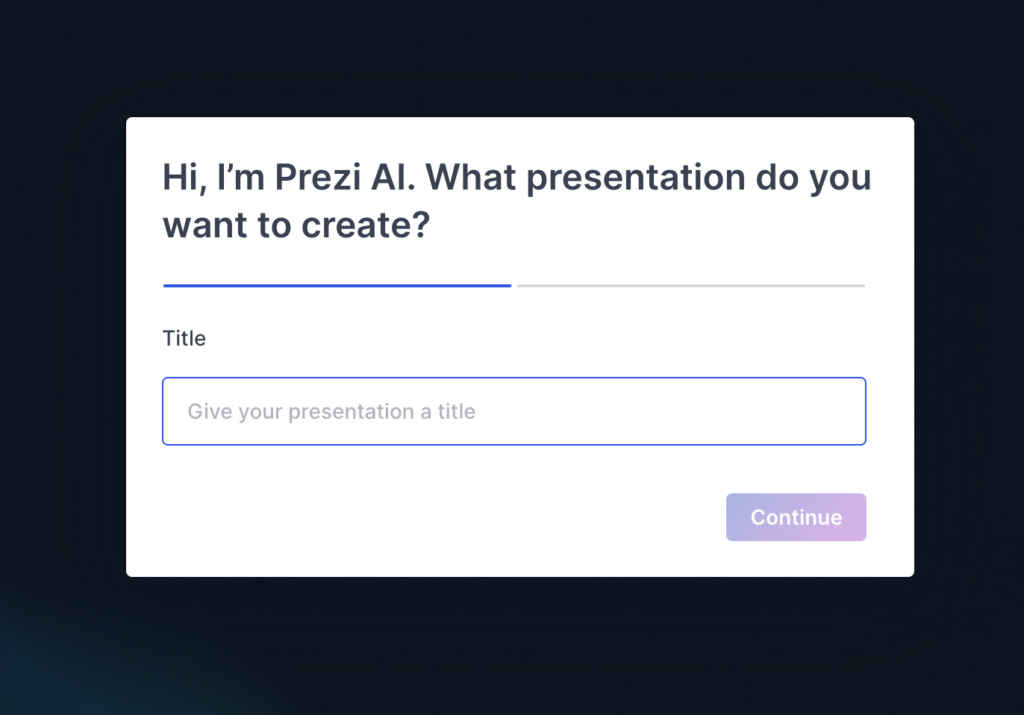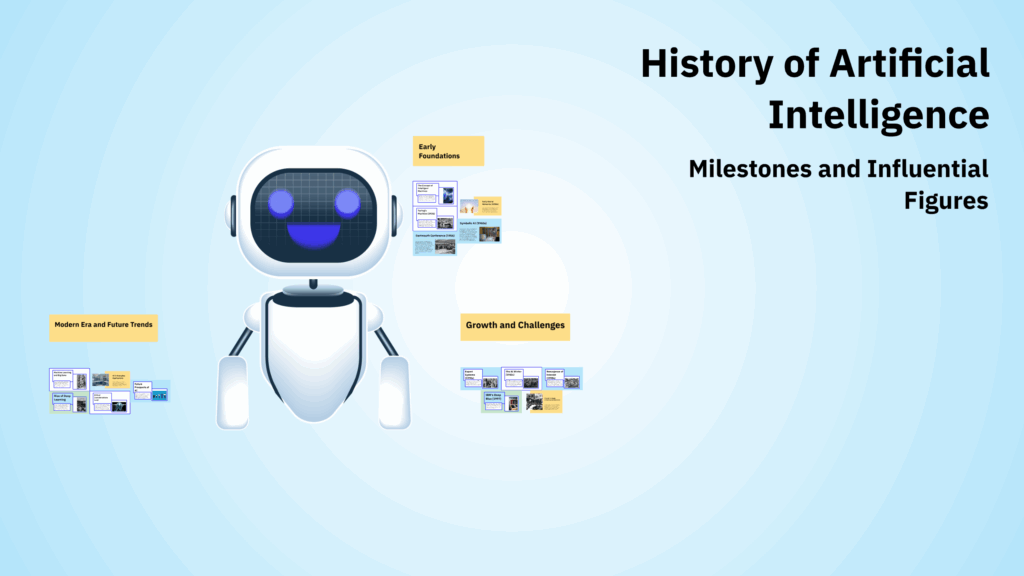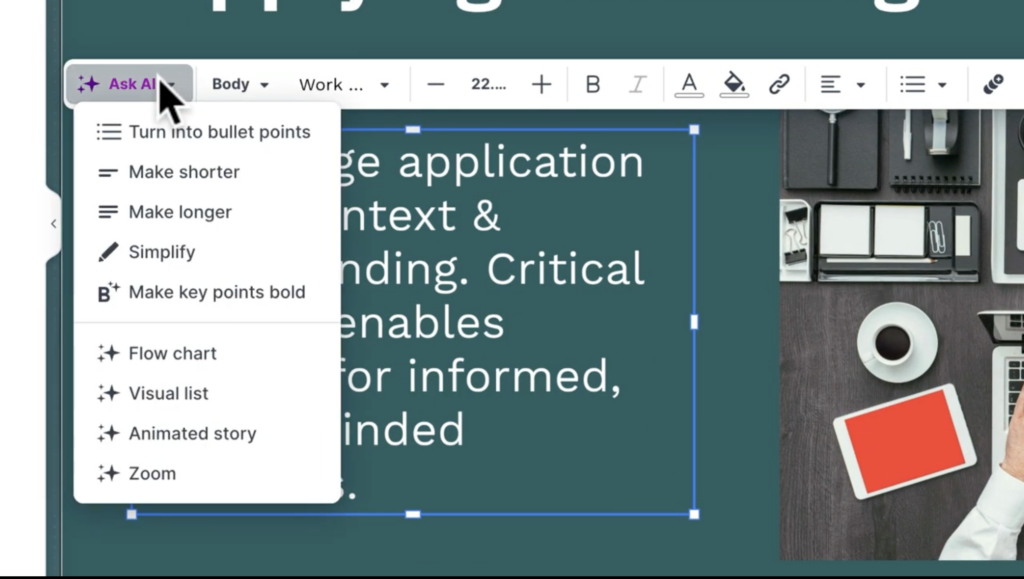Artificial intelligence is no longer a futuristic fantasy; it’s reshaping our world in profound ways. But how do you effectively communicate the complexities of AI in a presentation? So, when it comes to AI topics for presentations, you want to go beyond surface-level talking points. You want your message to land, inspire, and move people to action.
What you need is a roadmap on how to choose the right AI presentation topics, how to structure your talk, and deliver it with confidence. We will dive into a diverse range of AI topics for presentations, from the transformative potential of machine learning in healthcare to the ethical considerations of AI-powered automation.
In this blog, we’ll explore timely, thought-provoking generative AI topics for presentations and share how Prezi AI, the leading AI presentation maker, can help you turn even the most complex subjects into a visually stunning experience.
What are AI presentation topics?
AI presentation topics span across healthcare, education, business, and even creative industries. They examine how AI is transforming industries, its potential future impact, and the ethical considerations that come with its development. Think of it as exploring how AI is reshaping our world, both now and in the years to come.
Whether you’re showcasing how machine learning powers personalized medicine or explaining the ethical implications of generative AI, these topics spark curiosity and conversation. The key is to make them relatable and visually engaging. AI presentation topics also address the challenges we face, like algorithmic bias and data privacy, and consider the future of work in an AI-driven world. By exploring these diverse areas, your presentation can offer a comprehensive look at the multifaceted nature of AI.

Top AI topics for presentations
Here are some compelling generative AI topics for presentations:
AI in healthcare and medicine
AI is transforming healthcare in several exciting ways. From diagnosing diseases earlier and more accurately to streamlining drug discovery and creating personalized treatment plans, AI is making a real difference. Machine learning algorithms can analyze massive amounts of medical data, identifying patterns and insights that might be missed by human practitioners. This can lead to faster diagnoses and more effective treatments. Explore how AI is being used to develop new drugs and therapies, improve medical imaging analysis, and even personalize patient care based on individual genetic and lifestyle factors.
AI for business automation
Businesses are increasingly using AI to automate repetitive tasks, freeing up human employees to focus on more strategic work. AI-powered tools can analyze large datasets, providing valuable business insights and improving customer service. AI can also enhance marketing strategies by analyzing consumer behavior and preferences, allowing companies to create more targeted and effective marketing campaigns. Consider exploring how AI is being used in areas like customer relationship management (CRM), supply chain optimization, and fraud detection.
AI in education and personalized learning
AI has the potential to revolutionize education by creating personalized learning experiences for every student. Adaptive learning platforms use AI to assess student performance and tailor educational content to meet individual needs. This can lead to improved learning outcomes and a more engaging learning experience. Discuss how AI-powered tutoring systems, educational games, and personalized learning platforms are changing the way students learn. You can also explore the challenges and opportunities of implementing AI in education, such as ensuring equitable access to technology and addressing data privacy concerns.
AI ethics and responsible development
As AI becomes more powerful, it’s crucial to consider the ethical implications of its development and deployment. Explore important issues like algorithmic bias, fairness, and data privacy. A responsible approach to AI development requires careful consideration of these ethical challenges and implementing safeguards to ensure AI systems are used for good. Discuss the importance of transparency and accountability in AI systems and the need for regulations and guidelines to govern their use. The AI Now Institute is a great resource for learning more about AI ethics.
Natural Language Processing advancements
Natural Language Processing (NLP) focuses on enabling computers to understand and interact with human language. Recent advancements in NLP have led to significant improvements in machine translation, sentiment analysis, and text generation. Explore how NLP is being used to create chatbots, virtual assistants, and other conversational AI systems. Discuss the potential of NLP to improve communication and accessibility for people with disabilities. You can also explore the use of NLP in content creation and marketing. Consider showcasing innovative applications of NLP, like real-time language translation or personalized news summaries.
Key AI concept to include
A great AI presentation needs a foundation of key concepts. Explaining these clearly helps your audience grasp the complexities of AI. Let’s break down some must-have concepts:
Machine learning fundamentals
Machine learning is a core component of AI, focusing on algorithms that allow computers to learn from data. Instead of explicit programming, machine learning models identify patterns, make predictions, and improve their performance over time. There are three main types of machine learning: supervised learning, where models learn from labeled data; unsupervised learning, where models find structure in unlabeled data; and reinforcement learning, where models learn through trial and error. These approaches power various applications, from spam filtering to personalized recommendations.

Deep learning and neural networks
Deep learning, a specialized area within machine learning, uses artificial neural networks with multiple layers (hence “deep”) to analyze complex data. These networks mimic the human brain’s structure, enabling machines to process information in a hierarchical manner. Deep learning has revolutionized areas like image recognition and natural language processing, leading to breakthroughs in applications like self-driving cars and virtual assistants.
Computer vision applications
Computer vision empowers machines to “see” and interpret the world through visual data. This involves capturing, processing, and analyzing images and videos to extract meaningful information. Computer vision fuels applications like facial recognition, object detection, and medical image analysis. It’s transforming industries by automating tasks that previously required human vision, increasing efficiency and accuracy.
Generative AI and creative applications
Generative AI focuses on algorithms that create new content, ranging from text and images to music and code. Trained on vast datasets, these models learn underlying patterns and generate novel outputs that resemble the training data. Generative AI is pushing creative boundaries, with applications in art, music composition, and even creating realistic simulations. This technology is rapidly evolving, making generative AI topics perfect for presentations.
Structure your AI presentation for maximum impact
The key to effectively communicating complex AI topics for presentations is the structure. And with Prezi AI, structuring your ideas is no longer a time-consuming task; you now have a designer by your side. Just provide a strong prompt, and Prezi AI takes care of the rest, turning your input into a dynamic, visually engaging presentation that’s tailored to your message.

Start big
Begin by highlighting the transformative potential of AI. AI can refine content, optimize delivery, and ensure your message resonates with your audience. Consider showcasing a compelling statistic or real-world example to immediately grab their attention. This sets the stage for a deeper dive into specific AI applications and concepts. For example, you could discuss how AI-powered tools are revolutionizing industries like healthcare diagnostics or financial modeling.
Here’s how to organize your AI presentation for maximum impact, and how Prezi AI helps you get there faster:
Simplify complex ideas
AI often involves intricate concepts that can be challenging for a non-technical audience to grasp. Prezi AI simplifies your content structure so you can break down tough concepts into digestible points. Just describe the topic in your prompt, and Prezi AI will recommend layouts and transitions that guide your audience smoothly through each idea. You can focus on clarity and storytelling, while Prezi handles the design and flow.
Visualize AI concepts
Visual aids are essential for explaining abstract AI concepts. Use diagrams, charts, and infographics to illustrate complex processes like neural networks or machine learning algorithms. Incorporating multimedia elements, such as videos and animations, can further enhance understanding and engagement. Prezi can also help you determine where to place those elements based on your topic, so you don’t need to start from scratch.
Include interactive elements
Interactive elements can transform your AI presentation from a passive lecture into an engaging experience. Live polls, Q&A sessions, and quizzes can keep the audience involved and encourage active participation. AI-powered chatbots can even answer audience questions in real-time, providing additional information without interrupting the flow of your presentation. This level of interactivity fosters a deeper understanding of AI concepts and creates a more memorable experience for your audience.
Address ethical considerations in AI presentations
AI is transforming how we present, but it also presents some ethical dilemmas we need to consider. When incorporating AI topics for presentations, you need the content to inform and acknowledge the broader societal implications of artificial intelligence. By addressing these ethical considerations head-on, you demonstrate a thoughtful and responsible approach to this powerful technology.

Bias in AI systems
AI systems learn from the data they’re fed. If that data reflects existing societal biases, the AI can perpetuate and even amplify those biases. Imagine an AI tool designed to help with hiring that inadvertently favors certain demographics due to biased training data. This isn’t just a technical glitch; it’s a social justice issue. Examining and mitigating these biases is crucial for building fair and equitable AI systems.
Privacy concerns and data protection
AI often relies on vast amounts of data, raising legitimate privacy concerns. When discussing AI in your presentations, acknowledge the importance of data protection and responsible data handling. How is this data collected, stored, and used? Are there safeguards in place to protect sensitive information? Transparency is key to building trust. Explore resources like the Electronic Privacy Information Center (EPIC) for more information on data privacy and AI.
AI accountability and transparency
As AI systems become more complex, understanding how they make decisions becomes increasingly difficult. This lack of transparency can create distrust and hinder accountability. In your presentations, emphasize the importance of explainable AI (XAI), which aims to make AI decision-making processes more understandable. Who is responsible when an AI system makes a mistake? These are critical questions to explore.
Impact on employment and workforce changes
AI-driven automation has the potential to reshape the job market, leading to both job displacement and the creation of new roles. It’s important to address these potential impacts in your presentations. How can we prepare the workforce for these changes? What reskilling and upskilling initiatives are needed? Discussing these challenges and potential solutions demonstrates a forward-thinking approach. The World Economic Forum provides research and insights into the future of work and the impact of AI.
Future AI trends to captivate your audience
Want to keep your audience on the edge of their seats? Weaving these future-focused AI trends into your presentation will not only inform but also inspire. They offer a glimpse into the transformative power of AI and its potential to reshape our world.
AI in cybersecurity
AI is becoming essential in protecting our digital world. As cyber threats grow more complex, AI systems offer a proactive defense by detecting and preventing attacks in real time. Think of it as a highly vigilant security guard for your data, constantly monitoring for suspicious activity and responding swiftly to neutralize threats. This makes AI in cybersecurity a fascinating area to explore, especially when discussing the future of digital safety and data protection.

Advancements in AI-generated content
AI isn’t just about analysis and automation; it’s also stepping into the creative realm. We’re seeing remarkable advancements in AI’s ability to generate various forms of content, from writing compelling articles and marketing copy to composing music and creating stunning visuals. This has significant implications for creative industries, challenging traditional content creation methods and opening up exciting new possibilities. Explore how AI-generated content is changing the landscape of media production and consider the evolving role of human creativity in this new era.
The rise of explainable AI
As AI systems become more integrated into our lives, understanding how they make decisions is crucial. This is where explainable AI (XAI) comes in. XAI aims to make the decision-making processes of AI transparent and understandable, fostering trust and addressing ethical concerns. Imagine being able to see the “why” behind an AI’s recommendation, not just the “what.” This transparency is key to building confidence in AI systems and ensuring their responsible development.
AI in automation and robotics
AI is revolutionizing industries by powering automation and robotics. From manufacturing and logistics to healthcare, AI-driven robots are enhancing efficiency and productivity. These aren’t just simple machines performing repetitive tasks; they’re sophisticated systems capable of learning, adapting, and even collaborating with humans. Explore the diverse applications of AI in robotics and discuss how this trend is transforming various sectors, creating new opportunities, and reshaping the future of work.
Deliver an engaging AI presentation
Successfully presenting on artificial intelligence means understanding your audience and crafting your message to resonate with their level of knowledge. Here’s how to deliver an engaging and informative AI presentation.

Know your audience’s AI knowledge
Before diving into complex algorithms, gauge your audience’s familiarity with AI. Are they tech-savvy professionals, curious students, or a mixed group? Understanding your audience’s demographics—like age, profession, and educational background—is crucial, as these factors influence their existing knowledge and how they’ll perceive your presentation. This audience analysis is key. Tailor your content accordingly. For a less technical audience, start with foundational concepts. If you’re speaking to experts, you can explore more nuanced topics and current research.
Use relatable examples and analogies
AI can be abstract, so ground your presentation in real-world examples. Instead of just explaining neural networks, illustrate how they’re used in image recognition or spam filtering. Relatable analogies can also clarify complex ideas. For instance, compare machine learning to how humans learn from experience, gradually improving their skills over time. Personalizing your content with examples relevant to your audience’s interests and backgrounds makes the information more engaging and easier to grasp.
Encourage audience interaction
Transform your presentation from a monologue into a dialogue. Incorporate interactive elements like polls, Q&A sessions, or even AI-powered chatbots that can address audience questions in real time. This fosters a more dynamic and engaging experience. These interactive approaches not only keep the audience involved but also provide valuable feedback and insights.
Address common AI misconceptions
AI is often surrounded by hype and misinformation. Take the opportunity to debunk common myths and address concerns. Explain the difference between narrow or weak AI, which is designed for specific tasks, and general or strong AI, which remains largely theoretical. By proactively addressing these misconceptions, you build trust and ensure your audience leaves with a clearer understanding of AI’s capabilities and limitations. Researching your audience beforehand can help you anticipate their questions and tailor your content to address their specific concerns. Explore these helpful tips for using AI effectively in presentations.
Use Prezi AI to enhance your AI topics for presentations
AI is revolutionizing how we create and deliver presentations, and Prezi AI is leading the charge. Designed to act like a presentation designer by your side, Prezi AI supports every stage of the creative process—from structuring ideas and generating visuals to personalizing content and refining delivery.

Let’s explore some of the key ways Prezi AI is transforming presentations:
Prezi AI: The best AI presentation maker
Forget rigid templates. With Prezi AI, you get a personalized presentation experience built around your content and ideas, not a one-size-fits-all deck. Just enter a prompt, and Prezi AI instantly creates a non-linear presentation tailored to your message in seconds.
Customize without compromise
Prezi AI goes beyond design automation by evaluating your input to recommend visuals, layouts, and transitions that align with your topic and tone. Our growing library of design styles gives you the flexibility to match your brand or storytelling style, all while maintaining visual consistency and polish.
Start with a PDF
Got a research report or outline ready? Upload it as a PDF, and Prezi AI will extract and organize key content for you. Our AI combines advanced text analysis with vision models to transform dense information into an engaging, audience-ready presentation in seconds.
Enhance your text with “Ask AI”
Want to tweak your messaging? Use Prezi AI’s built-in “Ask AI” tool to shorten, expand, rephrase, or even transform your text into visual formats like flowcharts or animated sequences. You can also add zoom effects to guide your audience through key points—perfect for storytelling that sticks.

Smarter visuals and fonts, instantly
Let Prezi AI do the heavy lifting when it comes to styling. Our AI suggests relevant images based on your content, available directly in the Background and Media sidebar. It also recommends font pairings that fit your topic, ensuring your presentation looks cohesive and polished from the first frame to the last.
Ready to bring your AI presentation to life?
Artificial intelligence is reshaping every corner of our world—and your presentation should reflect that same level of innovation. Whether you’re unpacking the future of machine learning, diving into ethical debates, or inspiring a room with real-world AI applications, your message deserves more than static slides and generic layouts.
Prezi AI is your shortcut to smarter, more impactful presentations. It transforms your ideas into visually dynamic presentations that keep audiences engaged and inspired from start to finish. With powerful design automation, tailored content suggestions, and cinematic movement baked in, Prezi AI helps you focus on what matters most: delivering your message with clarity and confidence. Get started with Prezi AI today.
